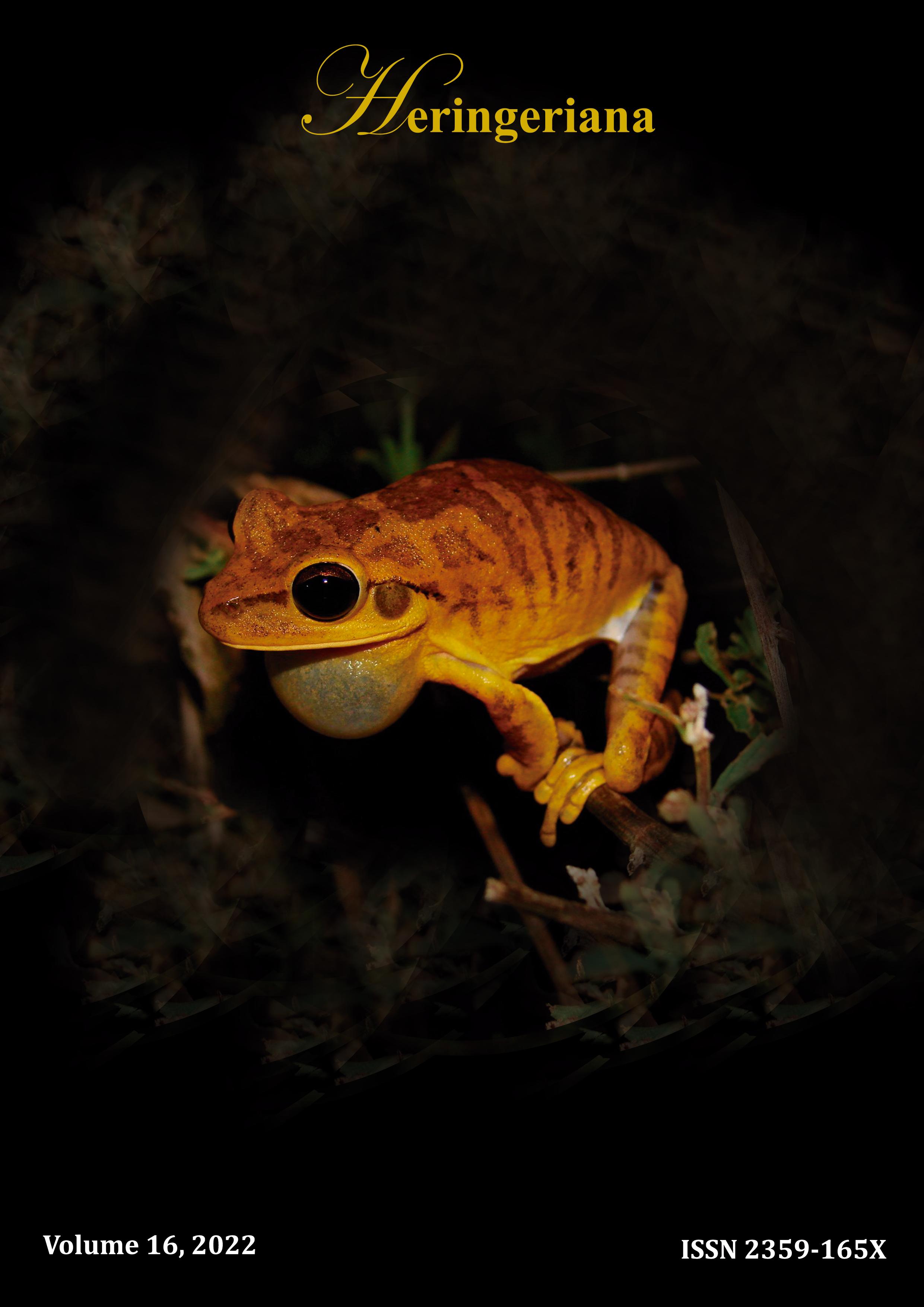The Amherstieae tribe (Leguminosae - Detarioideae) in the IAN Herbarium of Embrapa Eastern Amazon, Belém, Brazil
DOI:
https://doi.org/10.17648/heringeriana.v16i1.917975Palavras-chave:
biodiversity, Amazon rainforest, botanical collections, data computerization, legumesResumo
Herbaria are significantly relevant to science; updating and computerizing their data is essential for conducting future research. The IAN Herbarium (Embrapa Eastern Amazon) has an extensive collection of Leguminosae Juss., which was classically divided into three subfamilies; however, in 2017, a review was published proposing a new classification, dividing it into six subfamilies, among them Detarioideae. In 2018, Detarioideae was divided into six tribes, the largest of them Amherstieae. This large taxonomic recircumscription justifies a database update. The objective of the study was to carry out the survey, organization, computerization, and online availability of representatives of the tribe Amherstieae (Leguminosae – Detarioideae) at the IAN Herbarium. First, a survey was carried out on which genera of Amherstieae were represented in the collection. Their specimens were located and had their information inserted in the database and subject to quali-quantitative analyses. 976 specimens belonging to 10 of the 50 genera of Amherstieae were observed. The genus with the most specimens (600) was Macrolobium. The samples had origins in 9 countries, with 885 from Brazil, and from these, 438 from Pará, with 54 municipalities represented. The distribution of collections by mesoregions showed great heterogeneity with a concentration in Northeastern Pará and the Metropolitan Region of Belém. In conclusion, it is of fundamental importance that the Amherstieae data are disseminated, contributing to a greater offer of information regarding this group. Therefore, their data were included in the IAN Virtual Herbarium in January/2019, which can be consulted online from anywhere in the world, assisting in future research.
Referências
Brahms. (2019). Botanical Research And Herbarium Management System, V7. University of Oxford, Oxford. Available at: https://herbaria.plants.ox.ac.uk/bol/. (accessed: 23 February 2022).
de Candolle, A.P. (1825). Leguminosae. Prodromus systematis naturalis regni vegetabilis 2: 93-423.
Cronquist, A. (1981). An integrated system of classification of flowering plants. Columbia University Press, New York, 1262 pp.
de la Estrella, M., Forest, F., Klitgård, B., Lewis, G.P., Mackinder, B.A., de Queiroz, L.P., Wieringa, J.J. & Bruneau, A. (2018). A new phylogeny-based tribal classification of subfamily Detarioideae, an early branching clade of florally diverse tropical arborescent legumes. Scientific Reports 8(1): 1-14. https://doi.org/10.1038/s41598-018-24687-3.
Feitoza, G.V., Santos, J.U.M.D., Gurgel, E.S.C. & Oliveira, D.M.T. (2014). Morphology of fruits, seeds, seedlings and saplings of three species of Macrolobium Schreb. (Leguminosae, Caesalpinioideae) in the Brazilian Amazon floodplain. Acta botanica brasilica 28(3): 422-433. https://doi.org/10.1590/0102-33062014abb3341.
Gomes, J.I. & Martins-Da-Silva, R.C.V. (1997). Boletim informativo do Laboratório de Botânica Eng. Agr. João Murça Pires. Embrapa Amazônia Oriental, Belém, 16 pp.
IBGE – Brazilian Institute of Geography and Statistics. (2022). Divisão territorial brasileira. Available at: https://www.ibge.gov.br/geociencias/organizacao-do-territorio/estrutura-territorial/23701-divisao-territorial-brasileira.html?=&t=o-que-e (accessed: 22 February 2022).
Kiill, L.H.P. (2015). Herbário do Trópico Semiárido, Pernambuco (HTSA). Unisanta BioScience 4(6): 140-144.
Lewis, G., Schrire, B., Mackinder, B. & Lock, M. (2005). Legumes of the World. Royal Botanic Gardens, Kew, Richmond, 592 pp.
LPWG – The Legume Phylogeny Working Group. (2013). Legume phylogeny and classification in the 21st century: progress, prospects and lessons for other species–rich clades. Taxon 62(2): 217-248. https://doi.org/10.12705/622.8.
LPWG – The Legume Phylogeny Working Group. (2017). A new subfamily classification of the Leguminosae based on a taxonomically comprehensive phylogeny. Taxon 66(1): 44-77. https://doi.org/10.12705/661.3.
Mania, L.F. & Assis, M.A. (2008). Processo de informatização do herbário rioclarense (HRCB) da Universidade Estadual Paulista (UNESP), campus de Rio Claro, SP, e sua inclusão num sistema de rede. Revista Ciência em Extensão 4(1): 8-21.
Martins-da-Silva, R.C.V., Rodrigues, S.T., de Souza, F.I.B., Xavier Junior, S.R. & Souza, H.J.R. (2015). Herbário da Embrapa Amazônia Oriental, Pará (IAN). Unisanta Bioscience 4(6): 73-76.
Murphy, B., de la Estrella, M., Schley, R., Forest, F. & Klitgård, B. (2018). On the monophyly of Macrolobium Schreb., an ecologically diverse neotropical tree genus (Fabaceae-Detarioideae). International Journal of Plant Sciences 179(1): 75-86. https://doi.org/10.1086/695338.
Pacheco, C.A. (2004). Jardim Botânico do Rio de Janeiro: Memória e Arquivo. In: Martins, R.A., Martins, L.A.C.P., Silva, C.C. & Ferreira, J.M.H. (Eds.). Filosofia e história da ciência no Cone Sul: 3º Encontro. AFHIC, Campinas, pp. 110-114.
Royal Botanic Gardens Kew. (2022a). Macrolobium Schreb. Plants of the World Online. Available at: https://powo.science.kew.org/taxon/urn:lsid:ipni.org:names:331742-2 (accessed: 22 February 2022).
Royal Botanic Gardens Kew. (2022b). Crudia Schreb. Plants of the World Online. Available at: https://powo.science.kew.org/taxon/urn:lsid:ipni.org:names:327294-2 (accessed: 22 February 2022).
Royal Botanic Gardens Kew. (2022c). Cynometra L. Plants of the World Online. Available at: https://powo.science.kew.org/taxon/urn:lsid:ipni.org:names:22178-1 (accessed: 22 February 2022).
dos Santos, E.R., Santos, A.C. & Pereira, A.C. (2015). Herbário da Universidade do Tocantins, Tocantins (HUTO). Unisanta BioScience 4(6): 81-84.
Senna, A.R., Figueiró, R., Andrade, L.F., Sardella, C.J., Guedes-Silva, E., Souza-Filho, J.F., Miranda, G.S., Oliveira, G.R., Ferreira, R.L. & Docile, T.N. (2013). A importância e os desafios para o conhecimento e a catalogação da biodiversidade no Brasil. Acta Scientiae et Technicae 1(1): 53-86. https://doi.org/10.17648/uezo-ast-v1i1.8.
Senna, R.M., Martins, S. & da Silva, S.M.A. (2015). Herbário Alarich Rudolf Holger Schultz, Rio Grande do Sul (HAS). Unisanta BioScience 4(6): 249-252.
Smith, M.E., Henkel, T.W., Williams, G.C., Aime, M.C., Fremier, A.K. & Vilgalys, R. (2017). Investigating niche partitioning of ectomycorrhizal fungi in specialized rooting zones of the monodominant leguminous tree Dicymbe corymbosa. New Phytologist 215(1): 443-453. https://doi.org/10.1111/nph.14570.
Sousa, D.M.M., Bruno, R.D.L.A., Dornelas, C.S.M., Alves, E.U., Andrade, A.P.D. & Nascimento, L.C.D. (2010). Caracterização morfológica de frutos e sementes e desenvolvimento pós-seminal de Tamarindus indica L. - Leguminosae: Caesalpinioideae. Revista Árvore 34: 1009-1015. https://doi.org/10.1590/S0100-67622010000600006.
Souza, H.J.R., Martins-Da-Silva, R.C.V., Filer, D.L., Xavier Junior, S.R. & Fouro, A.M.M. (2013). Base de dados do Herbário IAN da Embrapa Amazônia Oriental. Embrapa Amazônia Oriental, Belém, 43 pp.
Souza, H.J.R., Rodrigues, S.T., Xavier Junior, S.R. & de Souza, F.I.B. (2015). O Herbário Virtual IAN da Embrapa Amazônia Oriental. Unisanta BioScience 4(7): 41-48.
Thiers, B.M. (2022). Index Herbariorum. New York Botanical Garden. Available at: http://sweetgum.nybg.org/science/ih/. (accessed: 26 May 2022).
Veloso, M.D.D.M., Mota, L.A.S., de Freitas, E.V.D., Souza, B.G. & Silva, J.R.T. (2017). A dinâmica do Herbário Montes Claros–MCMG. Unisanta BioScience 6(5): 151-155.
Yahara, T., Javadi, F., Onoda, Y., de Queiroz, L.P., Faith, D.P., Prado, D.E., Akasaka, M., Kadoya, T., Ishihama, F., Davies, S., Slik, J.W.F., Yi, T., Ma, K., Bin, C., Darnaedi, D., Pennington, R.T., Tuda, M., Shimada, M., Ito, M., Egan, A.N., Buerki, S., Raes, N., Kajita, T., Vatanparast, M., Mimura, M., Tachida, H., Iwasa, Y., Smith, G.F., Victor, J.E. & Nkonki, T. (2013). Global legume diversity assessment: concepts, key indicators, and strategies. Taxon 62(2): 249-266. https://doi.org/10.12705/622.12.
Downloads
Publicado
Como Citar
Edição
Seção
Licença
Copyright (c) 2022 Rebeca Rodrigues Crespo Teixeira, Sebastião Ribeiro Xavier Júnior, Eunice Gonçalves Macedo, Helena Joseane Raiol Souza

Este trabalho está licenciado sob uma licença Creative Commons Attribution 4.0 International License.
Ao fazer a submissão, os autores declaram não ter submetido o trabalho a outra revista e concordam em ter seu artigo publicado sob Licença Creative Commons Atribuição 4.0 Internacional BY (CC BY 4.0), que significa que os autores mantêm a propriedade dos direitos autorais, mas qualquer pessoa pode usar o conteúdo publicado, desde que os autores originais e a fonte sejam citados. O conteúdo científico, ortográfico e gramatical é de total responsabilidade dos autores.








